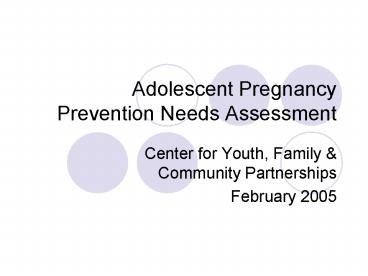Adolescent Pregnancy Prevention Needs Assessment - PowerPoint PPT Presentation
1 / 39
Title:
Adolescent Pregnancy Prevention Needs Assessment
Description:
Birth rate among African American teens 32% between 1990 and 2000 ... Gaps in services for minority teens relative to pregnancy rates. Services especially ... – PowerPoint PPT presentation
Number of Views:92
Avg rating:3.0/5.0
Title: Adolescent Pregnancy Prevention Needs Assessment
1
Adolescent Pregnancy Prevention Needs Assessment
- Center for Youth, Family Community Partnerships
- February 2005
2
National Data
- US teen pregnancy rate 84/1000 (2000)
- African American teens become pregnant at a
significantly higher rate than white teens
(153.3/1000 vs. 54.7/1000) - Hispanic teens also become pregnant at a
significantly higher rate than white teens
(137.9/1000)
3
US Teen Pregnancy Stats
- 18-19 year old teens account for 66 of teen
births - 80 of teen pregnancies are unintended
- 79 of pregnant teens are unmarried
- 34 of young women become pregnant before age 20
4
National Trends
- US teen (15-19) pregnancy rate ? 28 between 1990
and 2000 - Birth rate among African American teens ? 32
between 1990 and 2000 - Birth rate among Hispanic teens ? 20 between
1991 and 2002 - In 2003, birth rate for Hispanic teens highest
among all racial/ethnic categories (82.2/1000)
5
Teen Birth Rates 1990 2000By Race/Ethnicity
Hispanic
African-American
Amer. Indian
Total
White
Asian/Pacific Isl.
Source Ventura, SJ, Mathews, TJ and Hamilton, BE
(2001).
6
Teen Pregnancy Rates 1990 1997 By
Race/Ethnicity
7
North Carolina Data
- 9th highest teen pregnancy rate in US
- 2003 rate for 15-19 year olds 61/1000
- Non-white teens become pregnant at a
significantly higher rate than white teens
(54.2/1000 vs. 38.3/1000) (2002 data) - Hispanic teens (15-19) become pregnant at a much
higher rate than white teens (185.9/1000 vs.
61/1000) (2003 data)
8
Guilford County Data
- 2003 rate for 15-19 year olds 55.5/1000
- Teen pregnancy rates declined 36 between 1991
and 2000 - Non-white teens become pregnant at a
significantly higher rate than white teens
(72.3/1000 vs. 41.7/1000) - Young teens (10-14) become pregnant at rate of
20/1000
9
Effective Prevention What Works?
- Specific, narrow focus on behavior
- Based in effective, theoretical approaches
- Providing clear messages about sex and STD
protection - Providing basic, accurate information about
sexual behavior - Addressing social pressure
10
Effective Prevention What Works?
- Teaching communication skills
- Interactive activities
- Appropriate to age, sexual experience and culture
of audience - Sufficient length of time (gt14 hours)
- Training for teachers and peer educators
11
Guilford County Survey Overview
- September November 2004
- Interviews taken via phone, email, mail
- Snowball sample
- 15 agencies representing 40 programs responded
- gt50 response rate
12
(No Transcript)
13
(No Transcript)
14
(No Transcript)
15
(No Transcript)
16
Estimate 7640 youth served annually 8400
annual capacity
17
(No Transcript)
18
(No Transcript)
19
(No Transcript)
20
(No Transcript)
21
(No Transcript)
22
(No Transcript)
23
(No Transcript)
24
(No Transcript)
25
(No Transcript)
26
(No Transcript)
27
Faith Community Survey Overview
- October - December 2004
- Interviews taken via phone, email, mail
- Snowball sample
- 11 organizations representing 28 programs
responded - low response rate
28
(No Transcript)
29
(No Transcript)
30
(No Transcript)
31
(No Transcript)
32
(No Transcript)
33
(No Transcript)
34
(No Transcript)
35
(No Transcript)
36
(No Transcript)
37
45 of respondents report staff resources as a
barrier
38
To Be Addressed
- Gaps in services for minority teens relative to
pregnancy rates - Services especially needed for Hispanic and young
teens - Quality of programming in terms of best practices
?? - Limited evaluation of existing programs
39
Jennifer Kimbrough, M.Ed.Associate
DirectorCenter for Youth, Family Community
PartnershipsUniversity of North Carolina at
Greensboro336-256-1087
For more information about the contents of this
report, contact































